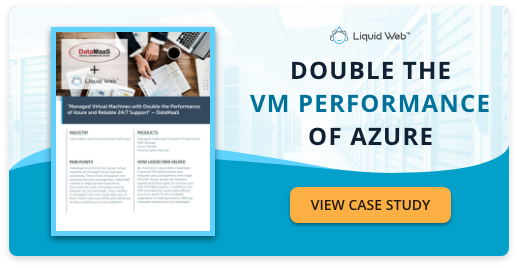
There’s no doubt that moving infrastructure to cloud servers is the future for nearly every company. The question you may be asking is: What’s the best time to make the migration and how do you do it? The process of moving workloads to the cloud can become incredibly costly and complicated if you don’t have a defined strategy ahead of time. A lift and shift cloud migration is one migration avenue that can minimize disturbance to your users.
Moving to a new cloud environment is always tricky, since the data is constantly used and updated, and new server connections need to be configured just right to avoid data flow interruptions.
A lift and shift approach is widely used for migrating your app to the cloud. But what does lift and shift data center migration entail and what are the exact benefits?
What is Lift and Shift Migration?
Lift and shift migrations, also known as rehosting, involve moving your entire application as-is to a cloud-based environment on an IaaS model (Infrastructure-as-a-Service).
A data center lift and shift migration strategy is considered to be the best way to move to the cloud without (necessarily) redesigning your application to suit new infrastructure.
Since you only make minimal changes to your app, you can save time and costs on development to get the benefits of cloud services and cloud computing in record time.
It’s common to compare lift and shift vs replatform and other cloud migrations.
Replatforming includes refactoring your application to be able to take advantage of the cloud provider’s IaaS as well as PaaS (Platform-as-a-Service) features. You can also choose to revise your code before rehosting or refactoring, or you can completely rebuild the architecture of your app.
Another option is to retire supporting your business application and use a third-party SaaS (Software-as-a-Service) alternative instead. In some cases, it’s possible to delegate the entire process with BPaaS (Business-Process-as-a-Service).
Why Move From an On-Premises Server to the Cloud?
There are multiple advantages to cloud servers. Unless you actively maintain and update your on-premises servers with new security features, cloud servers will be more secure, have better data management, proper encryption, redundancy, isolation, and more.
You can also update your cloud servers on the fly, while your apps are running, and always use only the amount of resources you need. Setting up new on-premises servers will likely require interruptions, more upfront costs, and be more difficult to implement.
Switching to the cloud also ensures reduced costs long term. Due to their scale, cloud providers operate at the highest level of efficiency and can provide fully managed services that let your engineers focus on building new features instead of managing networks. That’s why building your business processes around cloud computing can be very cost effective.
What are the 5 Types of Cloud Migration?

If you don’t want to undertake an overly complicated and time-consuming project, you might consider a data center migration lift and shift way. But there are also other types of migration that emphasize different priorities and might be more suitable for your situation.
Here are the five types of migration to consider:
1. Rehost (Lift and Shift)
Lift and shift migration, also known as rehosting, is a way to host your application with minimal changes using the cloud provider’s hardware infrastructure as IaaS. As a rule, you can migrate to the cloud quickly. The downside is an elevated ongoing cost compared to apps that run natively in the cloud.
2. Replatform
When you replatform your application, you incorporate more of the cloud provider’s software as PaaS — languages, frameworks, containers — to accelerate development and run your app more natively in the cloud. As a result, you lose some freedom of choice and risk lock-in.
3. Revise
If your on-premises hosted applications haven’t been upgraded in a while, it’s wise to do all the necessary changes before you move to a new infrastructure, whether you are going to rehost it or replatform it.
With revising, you can take advantage of the new hosting environment; however, revising does require more upfront investment in engineering.
4. Rebuild or Rewrite
The most extensive form of cloud migration is to either write new features to take advantage of the cloud or completely rebuild the existing application to include all the latest technology advancements.
If you choose to customize your app for the cloud provider’s environment, you’ll benefit from native-like performance but also risk significant lock-in.
5. Replace
You don’t have to continue to maintain your application to migrate to the cloud. If your application is not the core of your business, you can benefit from finding a comparable SaaS or a BPaaS to avoid spending valuable technical resources.
Benefits of Lift and Shift Migration
Lift and shift cloud migrations are relatively easy to orchestrate and can give you the power you need right now without extensive changes to your software.
Computing Power
As servers become faster and more efficient, it takes a lot of work and upfront investment to replace them on-premises. At the same time, legacy systems require more maintenance every year.
Migration Speed
It might be that you’ve been planning cloud migration for years, but it always seemed too complex and unwieldy to prioritize. Lift and shift allows you to migrate now and adapt your app to work natively on the cloud when the timing is right.
Security
Most businesses would improve every aspect of their app security by moving to the cloud. Backups, disaster recovery, updates, and redundancy are all easier to manage and improve in the cloud.
Cost Savings
While lift and shift might not be as cost effective as other cloud migration strategies, it will move your CapEx model to an OpEx-funded cloud infrastructure, which will reduce big upfront expenditures and infrastructure costs, since you won’t need to provision more resources than you actually need.
Drawbacks of Lift and Shift Migration
There are a variety of situations where lift and shift might not be the optimal strategy:
- Well-maintained on-premises servers might cost less for some applications than an unoptimized lift and shift migration.
- Depending on your industry, some cloud providers might not have the right certifications in place (e.g. HIPAA compliance).
- Smaller apps might take just a little more time for replatforming instead of rehosting.
- Larger, power-hungry apps might still benefit from leveraging on-premises hardware.
Using VMware Private Cloud from Liquid Web, however, these drawbacks can be easily negated. Liquid Web provides fully managed, highly available, and scalable infrastructure that is HIPAA compliant and has a simple pricing model.
When to Choose Lift and Shift vs Other Migration Types
Choosing the best way to migrate to the cloud depends on the condition of your on-premises servers, your resources, your existing application, and your priorities for the future.
Ask yourself the following questions:
- Is the app you want to migrate core to your business?
- Do you need to maintain the current app long term?
- Can it be lifted and shifted to cloud-based hardware without significant changes to the codebase?
- Is saving money a priority with this project?
- Do you want your infrastructure to become more agile?
- Are there comparable SaaS apps available on the market?
- Does the app need the security and enhanced controls of the private cloud, or would a public cloud be enough?
- Are there specific timeframes that need to be met with this project?
Answering these questions and having a consensus among your team will highlight the easiest cloud migration path forward.
Liquid Web and Cloud Migrations
Have more specific questions related to migrating your app to the cloud? Wondering how much storage space or computing power you need? Do you require custom modifications to your cloud server environment?
At Liquid Web, we’ve been helping thousands of customers all over the world with their server needs for 25 years and counting. Our VMware Private Cloud option is fully managed, based on highly available infrastructure and simple pricing, using only the resources you need. It also comes with 24/7 support and can be scaled at any time.
Contact us today, and one of our technicians would be happy to help you pick the perfect VMware Private cloud plan for your lift and shift migration.
[ad_2]
Source link







